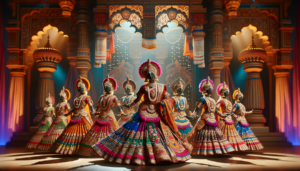Introduction to Foxtrot
The foxtrot is a timeless and elegant ballroom dance that has captivated dancers and audiences alike for over a century. With its smooth, gliding steps and lively rhythm, the foxtrot has become a staple in the world of competitive dance and social dancing. In this comprehensive guide, we will delve into the history of foxtrot, its unique characteristics, and the techniques needed to master this beloved dance style.
What is the Foxtrot?
The foxtrot is a ballroom dance characterized by long, continuous flowing movements across the dance floor. It is danced to big band music with a 4/4 time signature, typically at a tempo of 120 to 136 beats per minute. The dance combines slow, graceful steps with quick, syncopated movements, creating a delightful contrast that is both visually appealing and enjoyable to dance.
- Foxtrot is a smooth, progressive dance
- It is suitable for dancers of all skill levels
- The dance is performed in a closed position, with partners facing each other
Origins and History of the Foxtrot
The origins of the foxtrot can be traced back to the early 20th century, with various accounts attributing its invention to different dancers. One popular theory suggests that vaudeville performer Harry Fox introduced the dance in 1914, thus leading to the name “foxtrot.” As the dance gained popularity, it evolved and incorporated elements from other dances such as the one-step and the tango.
Throughout the 1920s and 1930s, the foxtrot became a sensation in dance halls and ballrooms across Europe and the United States. The dance’s popularity was further fueled by the rise of big band music and the influence of iconic dancers like Fred Astaire and Ginger Rogers, who showcased the foxtrot’s elegance and sophistication in their films.
Characteristics of the Foxtrot
Basic Steps and Techniques
Learning foxtrot begins with mastering the basic steps and techniques. The dance consists of a combination of slow and quick steps, with the slow steps taking two beats of music and the quick steps taking one beat each. The basic foxtrot step pattern is as follows:
| Step | Timing | Description |
|---|---|---|
| Step 1 | Slow | Forward step with the left foot |
| Step 2 | Slow | Forward step with the right foot |
| Step 3 | Quick | Forward step with the left foot |
| Step 4 | Quick | Bring the right foot beside the left foot |
Dancers should focus on maintaining good posture, with the head up, shoulders back, and arms held in a relaxed frame. The movement should be smooth and flowing, with the steps gliding across the floor.
Music and Rhythm
The foxtrot music is typically played by a big band or orchestra, featuring a strong rhythm section and lush instrumental arrangements. The music has a distinctive swing feel, with a slight emphasis on the second and fourth beats of each measure. Dancers must develop a keen sense of musicality to interpret the nuances of the music and express them through their movements.
Some notable foxtrot tunes include:
- “Cheek to Cheek” by Irving Berlin
- “Night and Day” by Cole Porter
- “Fly Me to the Moon” by Frank Sinatra
Foxtrot in Competitive Dance
Famous Foxtrot Dancers and Performances
Throughout the history of competitive dance, many famous foxtrot dancers have left an indelible mark on the dance world. From the silver screen to the ballroom floor, these dancers have captivated audiences with their skill, grace, and artistry.
One of the most iconic foxtrot performances was delivered by Fred Astaire and Ginger Rogers in the 1934 film “The Gay Divorcee.” Their rendition of “Night and Day” showcased the dance’s romantic and sophisticated nature, setting a new standard for foxtrot in popular culture.
In more recent years, dancers such as Michael Malitowski and Joanna Leunis have dominated foxtrot competitions, winning numerous titles and accolades for their exceptional performances. Their precise footwork, impeccable timing, and expressive style have made them role models for aspiring foxtrot dancers around the world.
Foxtrot in Dance Competitions
Foxtrot is a cornerstone of competitive dance, featured in both standard and smooth ballroom categories. In foxtrot competitions, couples are judged on their technique, musicality, and overall presentation. Competitors must demonstrate mastery of the basic steps while incorporating advanced figures and variations to showcase their skills and creativity.
Some of the most prestigious foxtrot competitions include:
- The Blackpool Dance Festival
- The World Championships
- The United States Dance Championships
Success in these competitions requires dedication, hard work, and a deep understanding of the dance’s intricacies.
Learning and Practicing the Foxtrot
Tips for Beginners
For those new to the foxtrot, learning the dance may seem daunting at first. However, with patience, practice, and the right guidance, anyone can master the basic foxtrot steps and begin their journey into this wonderful dance style. Here are some tips for beginners:
- Start with the basic steps and perfect them before moving on to more advanced figures
- Practice regularly to develop muscle memory and improve your technique
- Listen to a variety of foxtrot music to develop your musicality and timing
- Take lessons from a qualified instructor who can provide personalized feedback and guidance
Advanced Techniques and Variations
As dancers progress in their foxtrot journey, they can explore more advanced techniques and foxtrot variations to add depth and complexity to their dancing. Some examples include:
- Promenade and counter-promenade positions
- Hover steps and hover crosses
- Weaves and zig-zags
- Oversways and throwaway oversways
Incorporating these elements requires a solid foundation in the basic steps and a keen understanding of the dance’s mechanics. Advanced dancers often spend years refining their technique and developing their own unique style.
Conclusion
The foxtrot is a timeless and beloved ballroom dance that continues to captivate dancers and audiences around the world. With its rich history, elegant style, and enduring popularity, the foxtrot remains an essential part of the dance landscape. Whether you are a beginner just starting your foxtrot journey or an experienced dancer looking to refine your skills, this comprehensive guide provides the knowledge and inspiration to help you excel in this beautiful dance style. So put on your dancing shoes, find your rhythm, and let the magic of the foxtrot sweep you off your feet!






